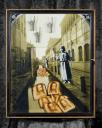LOU DUBOIS at “Dorothy’s gallery” in PARIS
Lou Dubois is a French artist whose name could be translated as “the big bad wolf from the woods”, like the fictional character from the story who devours and astounds people at the same time. We are talking here of an exceptional artist of a Surrealist strain who has graced French galleries for decades with his collages, Dadaist objects and his illustrations of poets’ biographies where he visually interpreted the work of Max Jacob, Breton and Apollinaire. In the introduction to the book entitled “Le Max Jacob” illustrated by Dubois, a critic has rightly observed that the illustrator’s sensibility and imagination have always matched the poet’s own. Dubois, who is also a poet, was born in Bourges, France and from his early years started paying particular attention to words and their special connotations. This great aficionado of the oneiric and the fantastic in art, discovered the poetry of Tristan Tzara for the first time at age sixteen. Later he expanded his poetic studies through numerous encounters with various poets, including friends of Andre Breton and his circle.
On his artistic path he will soon encountered the Dadaists and also discovered the magic of theatre which so mesmerized him that he started his own company, simply named “The Cabaret”. However, Dubois suggests that his real journey into the unknown began with his discovery of the unconscious, the religious and the spiritual, although he points out that he has never treated spirituality as a critique of the phenomenon of existence but rather as its aesthetic contemplation.
He has been obsessed with the increasing place of Dadaist objects in his life, which led him to his identifying art form: the assemblage of boxes which “define the world” and which, according to him “have tried to encapsulate the times” as exemplified in his butterflies which represent both split-second ephemeral beauty and the very denial of it. The artist says that behind all his artistic endeavours lies the desire to create visual poems, and he justly muses about the fact that today “no contemporary reader will start reading a book of poetry unless he’s visually encouraged to just look at it first.” And that is exactly what Dubois achieves. His works are poems expressed in three-dimensional object form : he says he always knows what he’s looking for and then at a given moment he will suddenly stumble upon it. He had looked for a certain Apollinaire poem and soon enough, he found an object which carried an excerpt from Apollinaire’s verse printed on it. His collages and objects are filled with references from Edgar Allen Poe’s imagery, as well as Baudelaire, Oscar Wilde or Arthur Rimbaud.
However, Dubois emphasizes that his visual commentary never imposes a specific interpretation on us, “I just suggest a range of different readings to a spectator, I never impose a definitive reading on him” he says. His attitude is best expressed in two collages: “Pardon” where we see the notorious Verlaine and Rimbaud on one of their escapades, and in a painterly collage where Freud, Tristan Tzara and Heidegger explore the subconscious through a story of parental incest. Or perhaps we could see it as a story of an insect which haunts Dubois in his numerous works acting like a replay of Dali’s frozen memories. The artist is, according to Dubois, an inveterate researcher who interrogates the unknown geography of our consciousness, be it real or imaginary. One of his major pieces is an enormous pharmacist’s chest, each of its myriad drawers labelled with the name of a poet : Prevert, Char or Reverdy. In each drawer he has tucked the verbal and pictorial secrets of their poetry along with tiny pieces of collected memorabilia so pertinent to the understanding of these poets.
His universe can be examined at Dorothy’s Gallery, 27 Rue Keller in Paris as a part of a larger thematic series entitled “Surrealism in Contemporary Art” which is on until the end of June. “Dorothy” is Dorothy Polley, a New Yorker who successfully continues the tradition of great Americans in Paris expanding the vision of art and culture on the both sides of the Atlantic.

